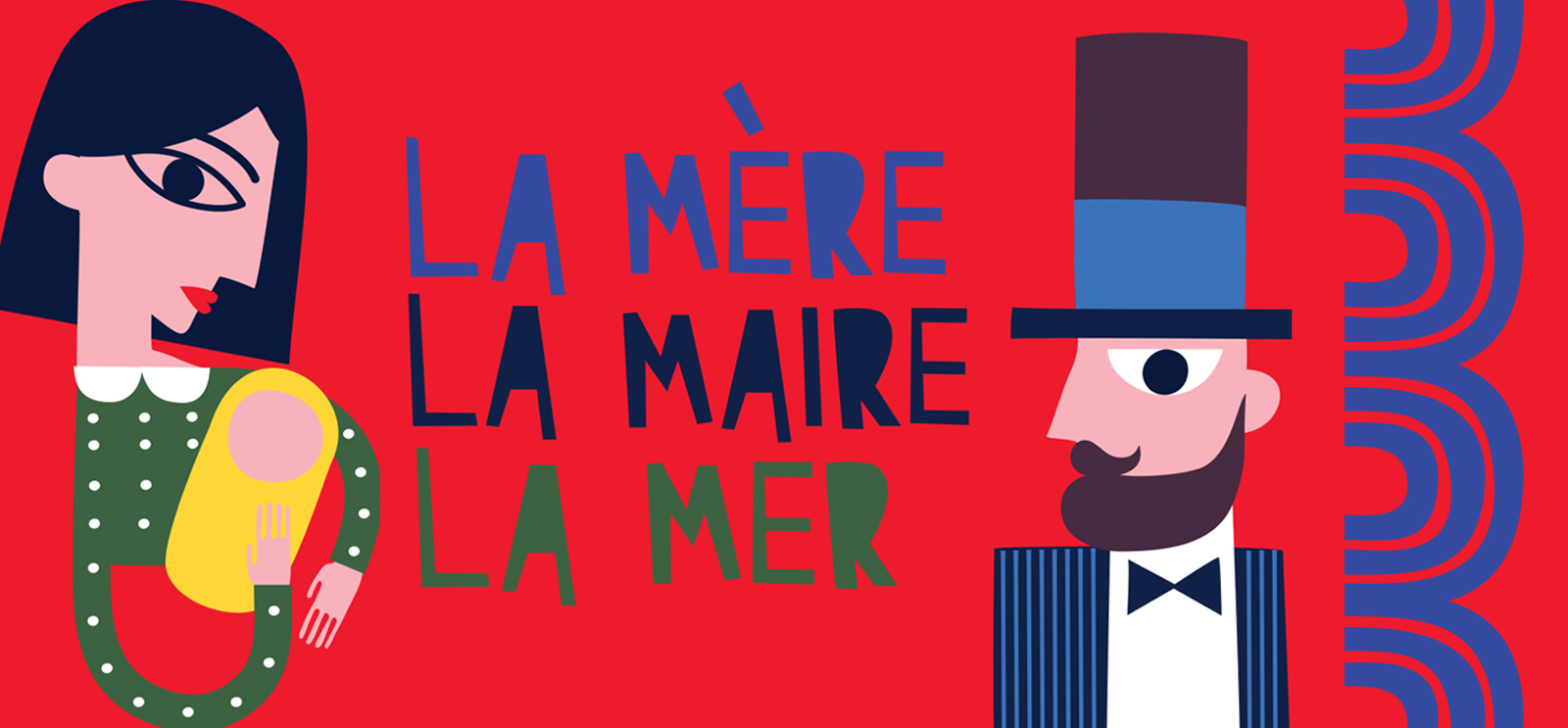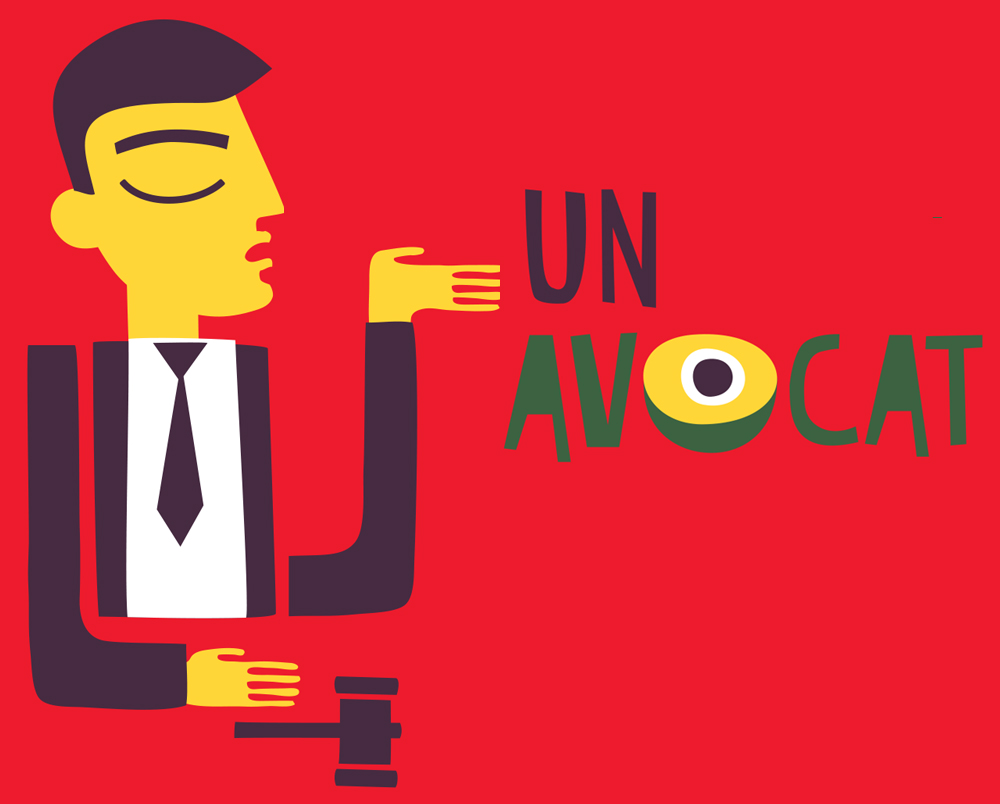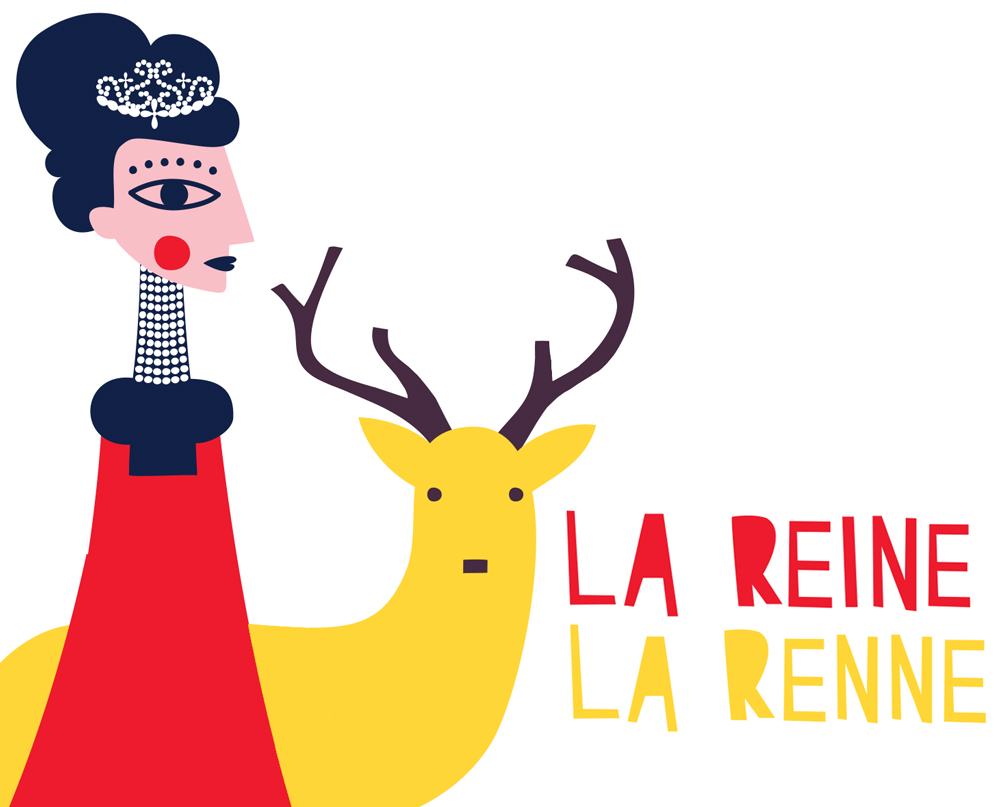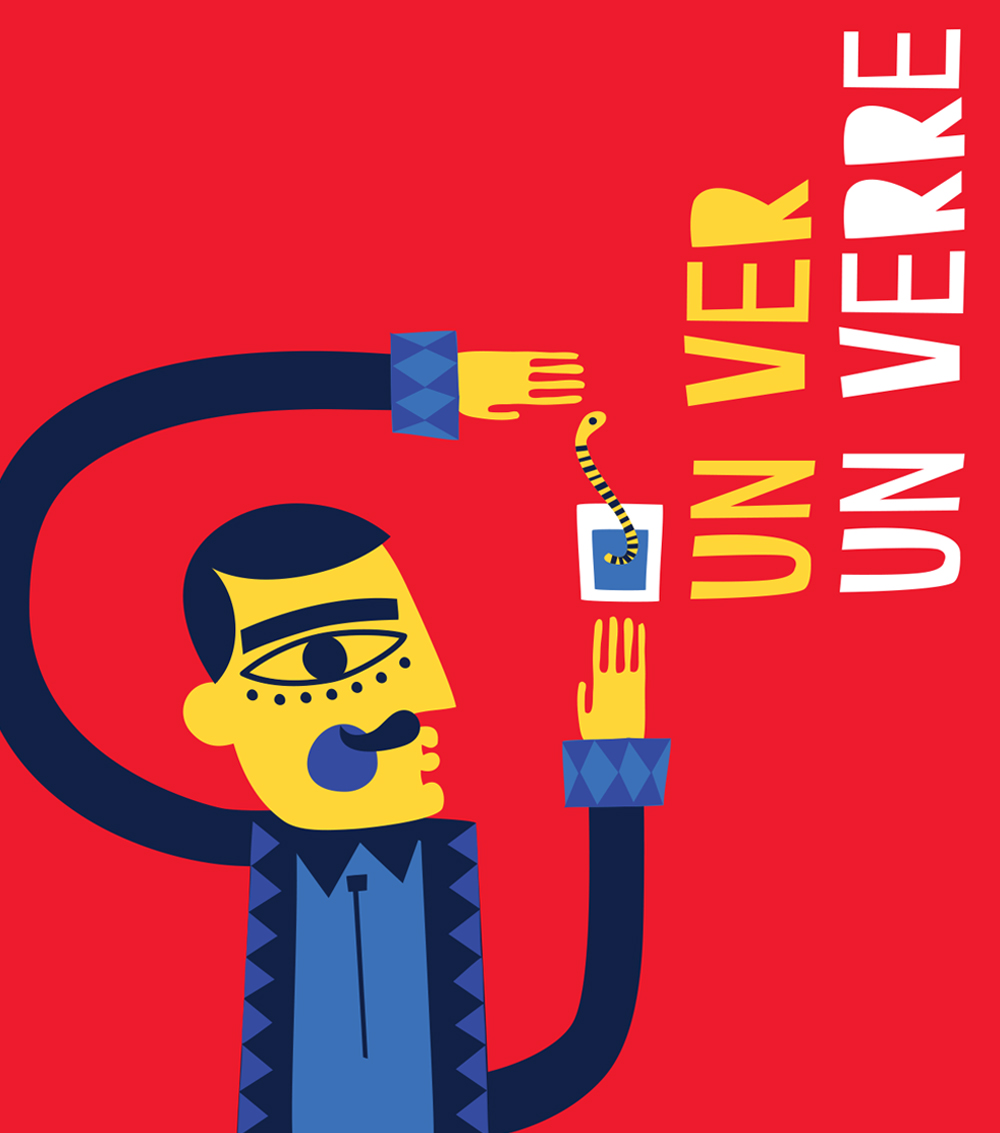
(Illustrations by Nearchos Ntaskas)
What if you took a language class and actually learned to speak?
What’s the French word for yes?
Oui, obviously, you might think, if you took French in high school or college. Or even if you did not.
That’s correct. But it’s not necessarily what a native speaker would say. “People most of the time will use ouais”—yeah—“instead of oui,” explains lecturer Céline Legrand, who’s a Parisienne. Roughly, “way” instead of “we.”
It’s just past nine on the first morning of summer elementary French, which compresses all of first-year French, three quarters’ worth, into eight manic weeks. The class meets in Cobb Hall for three hours Monday through Thursday with an additional speaking lab in the afternoons.
Today’s class begins with the usual basic phrases—bonjour, salut, comment allez-vous?—with one essential difference. The course is structured around recordings of native speakers. The students learn ouais because that’s what Juliette said to Marion in the video.
Claude Grangier and Nadine O’Connor Di Vito, creators of UChicago’s first-year French textbook, collected all the recordings themselves over decades. (They’ve gone through six formats in that time, beginning with cassette tapes, minitapes, and digital audio tapes. Since 2005 all of the clips are on video.)
Both Grangier, now the French language coordinator, and Di Vito, director of language programs, arrived in 1992. Soon afterward they began to develop their book, because “commercial textbooks were so unsatisfactory,” says Grangier. A short list of flaws: grammar mistakes big and small, no material on pronunciation, artificial dialogues that no French speaker would ever say.
Their self-published textbook—actually a workbook that students fill in during class time, so they discover the rules of the language themselves—has been used here for more than a decade. In fall 2018 Georgetown University Press will publish it as Comme on dit (As We Say). A second-year textbook, C’est ce qu’on dit (That’s What We Say), written by Grangier, Di Vito, and French lecturer Marie Berg, will come out soon afterward.
It’s not quite 9:30 and students have picked up another common French word: ben, which sounds like a nasal “bah” and “doesn’t really mean anything,” Legrand explains. It’s a filler word, the French equivalent of “um” and its ilk. If you’re searching for vocabulary and need to stall for time, ben is a really useful word to know. Ben, ouais. Well, yeah.
A few of the students have some background in French, others none. A woman in a black T-shirt asks optimistically if French nouns have the same genders as the equivalent words in Latin and Spanish. The answer is no.
By 9:45 the students are walking around the classroom, greeting each other in French. “I didn’t go to class for awkward social interactions,” one student mutters.
If that’s the case, he should have opted for a dead language, or perhaps built a time machine. At UChicago, as at universities across the nation, contemporary pedagogy for modern languages is focused on communication, with the plenitude of awkward social interactions that requires.

Just an hour into the class, the students’ vowels already sound noticeably more French. (Many French teachers claim beginners cannot learn pronunciation, “which is wrong,” says Grangier. “Not only can, but must be learned first thing.” It’s much harder to correct mistakes you’ve been making for years: “fossilized errors,” as Di Vito calls them.) To pick up each new chunk of vocabulary or grammar, the students listen to a recording or watch a video of college-educated French people speaking. Then they immediately imitate what they hear.
What sounds like “schwee,” for example, turns out to be je suis, I am, just mashed together.
The students pair up and practice confessing their inner state to each other: I’m sorry. I’m disgusted. I’m flattered. I’m angry. They don’t say je suis like French students. They say “schwee,” like French speakers.
Catherine Baumann, director of the University of Chicago Language Center—a resource for language teachers at UChicago—describes herself as “a product of the history of language instruction in the United States in the 20th century.” In elementary and high school, she studied Spanish but didn’t learn much and didn’t enjoy it: in the terminology of language teaching, the curriculum was “poorly articulated.”
During college Baumann took French and liked it. She taught seventh grade for a year—“the worst year of my life”—before returning to the University of Minnesota to study German. Baumann is of German heritage but had learned “not a syllable” growing up.
She studied abroad in Salzburg and northern Bavaria, then stayed on for two years as an elementary school teacher at the US Army base in Erlangen. Though she had not begun her German studies until age 23, eventually she spoke so fluently, “I could go incognito,” she says. “I was indistinguishable from a native speaker.”
Baumann’s accomplishment is enviable—especially if you’ve had the all-too-common experience of earning As in language classes for years, only to discover, in the country where the language is spoken, that you can’t even order a cup of coffee. The contemporary approach to language teaching, ideally, will prevent that soul-crushing moment.

Today the watchword in language teaching is proficiency. The shift began in the late 1970s and early ’80s, when the American Council on the Teaching of Foreign Languages (ACTFL) adapted the US government’s oral exams for Foreign Service employees. “The federal government has been teaching language for a century, because they place people in jobs where they need to use language,” says Baumann. Just because someone has taken two years of Japanese or majored in French, “What does that mean? Nothing.”
The verbal tests show what you can really do. ACTFL recognizes five major levels of proficiency: novice, intermediate, advanced, superior, and distinguished. Novice, intermediate, and advanced are further subdivided into low, mid, and high. The levels are consistent across languages. An intermediate-mid in French or Japanese can do approximately the same things in their respective languages. It just may take longer—if you’re a native English speaker—to get to that point in Japanese.
When you speak, “you’re doing the maximal manifestation of knowledge,” says Arabic lecturer Noha Forster. “To speak is to have worked so hard. You’ve done the vocabulary, you’ve read, you’ve translated, you’ve written, now you can actually speak, with no aids. It’s the hardest and scariest thing to do.”
Once the new proficiency standard was adopted, classroom instruction had to change too, says Baumann: “The goal becomes teaching toward functional ability, instead of teaching toward knowledge about grammar and vocabulary.” Put simply, students no longer learn about the language—like a linguist might — to understand its structure and subtleties, or to compare it to other languages. Instead, students learn to use the language they’re studying.
Textbooks began to change. “A chapter that used to be called ‘The Past Tense’ is now called ‘Childhood Memories and Telling Stories,’” says Baumann, “because that’s what you do with the past tense.” Then came an emphasis on authentic materials, from magazines to movies to mundane exchanges between native speakers: “In the real world, that’s what you’re going to be confronted with.”
As language pedagogy was changing, technology began to undergo its own independent seismic shift. In 1999, when Baumann arrived at UChicago as a German lecturer, students who wanted to hear native speech would go to the language lab. Teachers who wanted to show a foreign movie in class would check out a VCR (the tech-savvy University owned VCRs that could play European-standard tapes) and roll it to the classroom.
The internet transformed all that. Now, when Forster wants to show her beginning Arabic class, say, how Turkish coffee is made, she can choose from a selection of YouTube videos in a number of Arabic dialects. All the classrooms in Cobb are “smart,” with large flat-screen displays; that upgrade happened a dozen years ago.
The video Forster chooses features a woman from the Persian Gulf who explains how to prepare coffee with condensed milk. “Sweetened condensed milk—don’t,” Forster says. “It’s like putting ketchup on sushi.” The students laugh.
Later in the class, she passes out a worksheet of questions. The 15 students are assigned to walk around the room and interview three others. “It’s been proven that when people walk around, they learn more,” she tells them.

Forster and the University’s other Arabic instructors rely on a textbook, Alif Baa (Georgetown University Press) for the beginning class. (Alif and baa are the first two letters of the Arabic alphabet.) But Arabic in Social Context, her class for more advanced students, could not exist without the internet. Forster finds clips online and prepares her own worksheets. Students can watch the clips anywhere, 24 hours a day, over and over, slowed down if necessary.
There’s an additional challenge with teaching Arabic proficiency, Forster says: “the diglossic quality of a written versus a spoken language.” The written version, Modern Standard Arabic (MSA), derives from classical Arabic, the language of the Koran. It’s the language of literature and journalism—but not conversation. “I’m not going to speak to my mom in this language,” says Forster, who comes from Cairo and would use Egyptian colloquial Arabic.
So if you want to speak Arabic, you have to choose. There are four primary dialects: the Arabic spoken in Egypt and Sudan, in the Persian Gulf (Saudi Arabia, Kuwait), in the Levant (Syria, Jordan, Lebanon, Palestinian territories), and in North Africa (Morocco, Tunisia, Algeria). The first three are mutually intelligible for the most part, but the North African dialect, Maghrebi, “can be pretty opaque to the rest.” There are also regional variations within each: “I can’t tell you how many linguistic studies have been done on various dialects just in Palestine,” Forster says.
Arabic has been taught continuously at the University since 1893. In the beginning, it was probably taught as a dead language, Forster says, with an emphasis on grammar and translation, and no concerns about dialects. But the proficiency approach “is really what’s in vogue now.”
“It’s been very gradual, the movement from treating it as a dead language to treating it as we would Spanish, like a language you’re supposed to become proficient in, walk out in the street and speak in.” The proficiency approach, “which is entrenched in all of the other commonly taught languages,” she says, “is forcing its way onto the less commonly taught languages.”
It’s now week three of intensive French. The students can tell stories and talk about what happened yesterday—that is, in linguistic terms, they have learned the passé composé, the past tense.
They have also lost the hard r’s that mark (or you could say mar) the pronunciation of the vast majority of American tourists in France. Legrand reads a list of verbs on the board—dormir, lire, manger, and trickiest of all, regarder—as the class repeats. No one sounds American; a few sound uncannily French.
Nonetheless denial, or perhaps exhaustion, has set in. Students seem aggrieved by the inconsistencies of French, outraged by its differences from English: “Now we decide to drop the article?” one man complains.
At another point in the class, the same student asks if brun (brown) can be used to describe eyes. Legrand explains this word is for hair only. Eyes are marron or noisette, hazelnut.
“Pourquoi?” another man asks. Why?
“I don’t know. Parce que,” Legrand says, smiling: because. “When children ask too many questions, you say, ‘Parce que.’”
Her cheerful deflection is like a child’s version of the new pedagogy: Do or do not. There is no why.
UChicago offers a superabundance of less commonly taught languages (LCTLs for short, pronounced LICK-tulls), primarily to graduate students: Akkadian, Bangla (Bengali), Demotic, Ge’ez, Haitian Kreyol, Hieratic, Hittite, Luwian, Marathi, Swahili, Syriac, Tamil, Ugaritic, Uzbek, Yucatec Maya, and three dozen more. But not Icelandic. Until a few years ago, students who wanted to study Icelandic had to take it elsewhere during the summer—or they were just out of luck.
In 2014 the University joined CourseShare, run by the Big Ten Academic Alliance. Now a student at UChicago can enroll in an Icelandic course at the University of Minnesota, sit in a classroom in Cobb, and attend the class by videoconference.
This academic year UChicago is sharing its Polish, Tibetan, and Catalan courses with other institutions. Catalan, taught by lecturer Alba Girons Masot, has eight students: four in Chicago, four in Minnesota. Girons Masot comes from Sabadell, Spain, a small city near Barcelona, and has never been to Minnesota. She keeps regular office hours for her Chicago students and online office hours for the Minnesota ones.
The class meets in the UChicago Language Center on the second floor of Cobb. The swanky center, which celebrated its 10th anniversary this year, includes a number of tiny glass-walled teaching spaces, called pods, which seat just a few people. Pods are used for LCTLs, many of which have tiny enrollments. There are also two classrooms with videoconferencing equipment. The larger of the two, where Catalan is taught, seats 10.
In 2016 the language center received a $2 million grant from the Andrew W. Mellon Foundation to go beyond ad hoc course sharing. The program, which runs for five years, pairs LCTL instructors from different institutions to develop shared course sequences. The idea is to “let them work together instead of in isolation,” says Baumann, to get better curricula—and therefore better language speakers.
The grant also supports professional development conferences aimed at LCTL teachers. The two-day Mellon Winter Workshop, held in February, attracted 60 participants to sessions such as “Grammar by Night, Meaningful Interaction by Day” and “(Cost-)Effective Vocabulary Instruction.”
“Bon dia!” Girons Masot calls cheerily to the Minnesota students when they appear on screen. The class, an accelerated course for beginners, is in its second quarter and taught almost entirely in Catalan. At one point there’s a technical glitch; Minnesota cuts out. When Nicholas Swinehart, the language center’s multimedia pedagogy specialist, comes in to investigate, Girons Masot accidentally thanks him in Catalan, a language he doesn’t speak. She laughs. He seems to understand anyway.
If you know any Romance language, Catalan sounds like a distant radio station: you can follow it, but it keeps fading in and out. Catalan, spoken in parts of Spain, France, and Italy, is not a dialect of Spanish, contrary to the common misconception; it’s a language, and closer to Italian or French. It was also banned in Spain from 1939 until after Spanish dictator Francisco Franco died in 1975. “For years, saying ‘Bon dia’ was a political statement,” Girons Masot says. Children were punished for speaking Catalan at school; adults spoke it privately but not in public. Now it’s the language of instruction in public schools in the Catalonia region of Spain, where Catalan-Spanish bilingualism is the norm.
Today’s class focuses on food and shopping. Girons Masot passes out words written on slips of paper to the Chicago students, by email to the Minnesota ones. The students break into pairs: one tries to describe the food, the other to guess it. “Una fruita seca?” one student says doubtfully: a dry fruit? The word turns out to be ametlles, almonds.
Immersive games like this don’t just make language learning more fun and less like drudgery; they are intended to make the most of classroom time. As Swinehart explained during the vocabulary session at the Mellon Winter Workshop, the goal is for students to learn words outside of class and then practice them together during class. Swinehart and Baumann demonstrated several ways—high tech and low tech—to accomplish this, from online classroom games like Kahoot! that students use their phones to play, to childhood favorites like hangman and charades. (Baumann enjoys asking her beginning German students to mime the verb sein, to be. “They can handle it,” she says.)
Like Baumann, Swinehart has a complicated language learning history. “I learned French at one point, and Italian, and Arabic, but I can’t use any of those,” he says. “I can use Chinese, the one language I didn’t actually take any classes in.” He picked it up while teaching English as a second language in China. “Not to say that classroom learning is necessarily inferior,” he adds quickly, “but the more you use a language for meaningful communication, the more you become functional and proficient.”
In contrast Girons Masot, who speaks French, Italian, and English as well as her native Catalan and Spanish, is an addict for classroom learning. Every other summer, she travels somewhere new to take intensive language classes; she’s studied German, Swedish, and Icelandic. As a language instructor, she says, it’s useful to remind herself what it’s like to be confused in a classroom: “That’s what my students are experiencing.”
It’s August 9, the last day of intensive French. The students are reviewing for the final in pairs, changing partners every few minutes, as they have done innumerable times by now.
Lecturer Isabelle Faton, PhD’16, who’s been teaching the last four weeks of the course, circulates as the students practice. She listens in, correcting pronunciation and supplying vocabulary when necessary.
“How do you say ‘wow’ in French?” one man wants to know.
“Wow,” Faton says, “but it’s spelled a little differently.” She walks to the board and writes ouah.
The students talk much more slowly than the rapid-fire native speakers they’ve been imitating all quarter. Nonetheless they form full French sentences, only rarely lapsing into English. “At the end of 101, I’m still amazed after 20 years,” says textbook coauthor Grangier. “They can pronounce. Of course, they don’t all have the r or the on or the u. But French people are going to understand them.”
If you close your eyes, it doesn’t sound like a language class at all. It’s more natural, more conversational: voices rising and falling, tumbling over each other, punctuated now and again with easy laughter. In fact it sounds a little like a party.
In eight short weeks, the students have learned to speak French. Ouah.

What’s a LCTL?
LCTL (less commonly taught language) is “a relative term,” says Catherine Baumann of the University of Chicago Language Center. “At UChicago we call LCTLs any language with less than about 100 annually enrolled students.” So at some universities, Arabic is a LCTL, but here it isn’t.
| Commonly taught languages at UChicago, 2016–17 |
LCTLs taught at UChicago, 2016–17 |
|
| American Sign Language Arabic Chinese French German Hebrew Italian Japanese Korean Portuguese Russian Spanish Turkish |
Akkadian Aramaic Armenian Assyrian Babylonian Bangla (Bengali) Basque Bosnian/Croatian/Serbian Catalan Czech Demotic Egyptian (Old) Egyptian (Middle) Egyptian (Late) Ge’ez Greek (Ancient) Greek (Biblical, Koine) Greek (Modern) Haitian Kreyol Hieratic Hindi Hittite Kazakh Latin Luwian Marathi Norwegian Persian Polish Sanskrit Sumerian Swahili Syriac Tamil Tibetan Ugaritic Urdu Uzbek Yucatec Maya |
